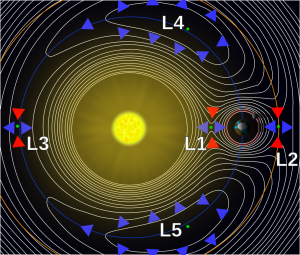Gaia arrives at its destination
Wednesday, 25 February, 2015
In January 2014, Gaia arrived at its deep space location, ahead of conducting its primary mission of observing one billion stars. The European spacecraft is now at the Lagrangian point (L2), which is 1.5 million kilometres directly ‘behind’ the Earth as viewed from the Sun, and is classed as an ideal place from which to observe the larger Universe.
Located at L2, Gaia does not need to orbit Earth, and so it is spared from sweeping in and out of our planet’s shadow, heating up and cooling down, and distorting its view. Indeed, L2 provides a moderate radiation environment, which helps extend the life of the instrument detectors in space.
There are five Lagrangian locations where the gravitational forces and the orbital motion of the spacecraft, Sun and planet interact to create a stable location from which to make observations.
